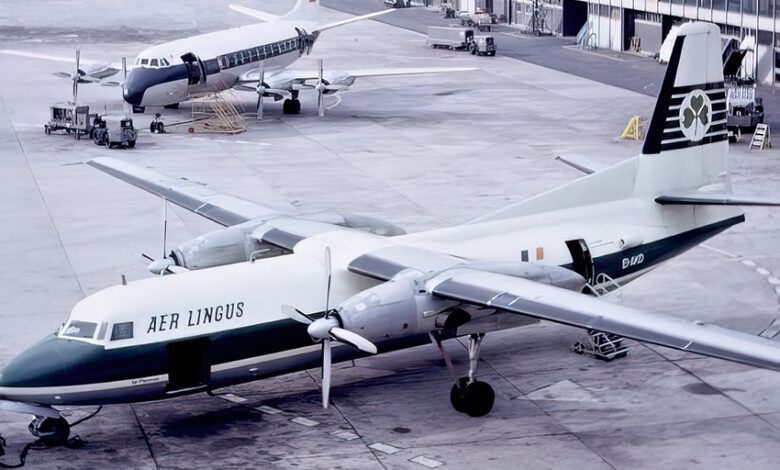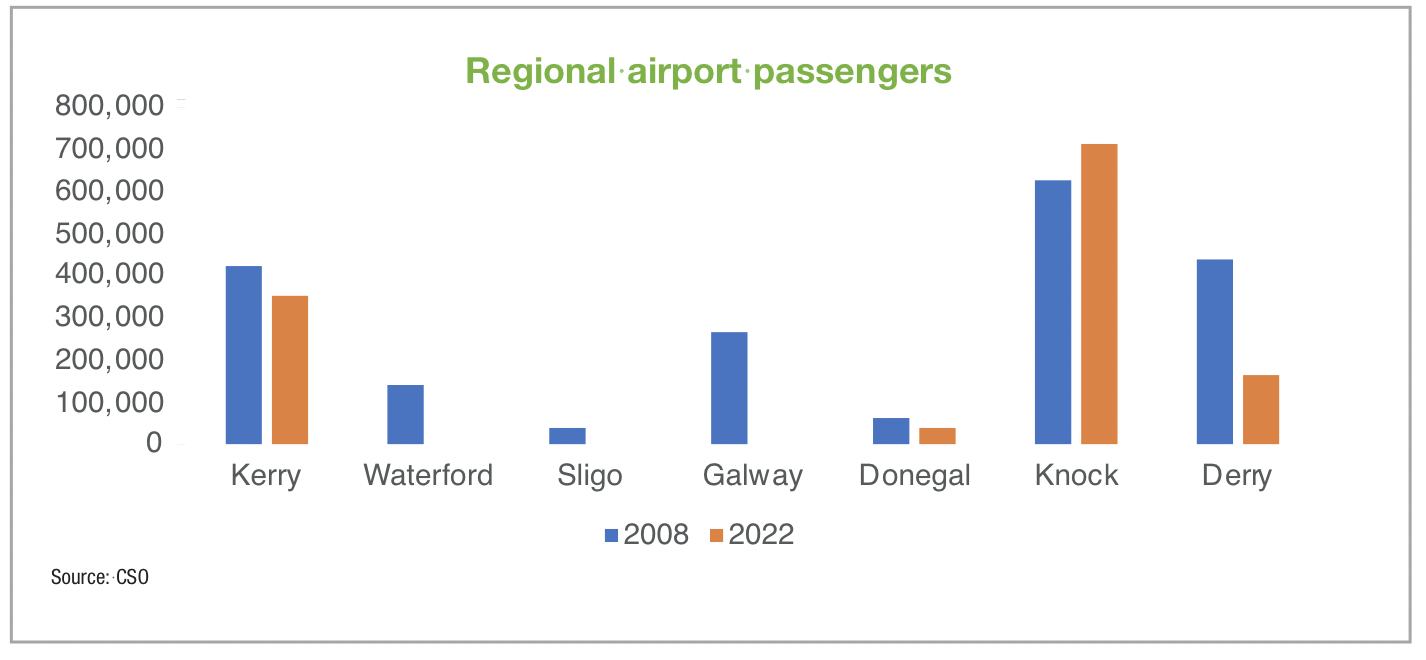Why Ireland’s regional airports have declined

Whilst the Irish economy has rallied since the 2008 financial crisis, one sector which remains diminished is Ireland’s regional aviation sector, with all regional airports in the State, aside from Knock, having not recovered to pre-recession traffic.
In 2008, there were six significant regional airports in the State and one in the North handling commercial passengers. However, in 2022, six of the seven regional airports in Ireland have seen significant reduction in passengers handled, with three of the airports currently not handling passenger traffic.
Through the country, this decline can be seen through the decline in overall regional traffic, with an estimated 2,013,040 passengers having passed through Ireland’s regional airports in 2008. In 2022, however, this figure dropped to 1,264,792 – a decline of 38 per cent.
The history of Irish aviation
To understand the scale of this decline, it is important to understand the development of the aviation sector in Ireland. Until 1983, there were no motorway infrastructure in the State, leaving smaller cities and towns in Ireland relatively isolated from the economic hub in Dublin.
The importance of being linked to Dublin became more prevalent in the 1960s as then-Taoiseach Seán Lemass introduced economic reforms which led to increasing centralisation of the economy in Dublin.
In 1984, Aer Lingus – then owned by the Government – established a regional subsidiary, Aer Lingus Commuter, which was centred on increasing the connectivity to Dublin from smaller counties and from the UK. Routes operated from Dublin to all the State’s regional airports, as well as Derry in the North and various British airports.
It is furthermore important to note that, at this stage, Aer Lingus had a monopoly on commercial air traffic in the Irish aviation sector, with Ryanair not coming into existence until the late 1980s. The formation of Ryanair – initially based at Waterford Airport – led to a new trend in the Irish aviation market, the desire for ‘no-frills’ and affordable air travel. It made aviation more accessible for sectors of the population on lower incomes and presented an economic challenge to Aer Lingus.
For decades, Aer Lingus had been able to operate on losses due to its government ownership, with the Boeing 747 having reportedly never been profitably operated by the national carrier.
As Ireland moved into the 2000s, Ryanair was experiencing a passenger boom which saw its operating model gain increasing momentum. The Fianna Fáil-Progressive Democrat coalition decided that the most commercially viable path for Aer Lingus to compete with this challenge from its low-cost competitor was to privatise the airline, with the Government selling a majority of its shares in the national carrier in 2006.
Aer Arann and the PSO scheme
As Aer Lingus adapted to the market challenges presented by the emergence of Ryanair, a small, island-based airline, serving the Oileáin Árann with a single Britten Norman Islander, saw a gap in the market which could be exploited by the increasing commercialisation of Aer Lingus.
Aer Lingus Commuter was discontinued in 2001, but in the 1990s it had already been refocused on profitability, meaning that the regional routes had already largely created amid new focus now on connecting Dublin with air routes in Britain.
With this decline in Aer Lingus traffic, Pádraig Ó Céidigh and Eugene O’Kelly, who purchased Aer Arann Islands in 1994, subsequently re-naming it Aer Arann, saw the potential with the use of the Public Service Obligation (PSO) scheme for a dedicated airline which connected Dublin with the regional airports of Ireland, as well as the benefits of enhanced connectivity from opposite ends of the island, resulting in commercial routes such as that between Cork and Belfast.
Ó Céidigh and O’Kelly began to expand the airline’s routes and fleet, launching scheduled services in 1998. Also in 1998, the Government awarded the airline the PSO route between Donegal Airport and Dublin Airport followed by the PSO route between Sligo Airport and Dublin. By 2007, the success was such that Aer Arann had a turnover of €100 million and passenger numbers in excess of 1.15 million.
Recession and decline
In 2008, as Ireland entered the first year of what would become a crippling recession, Aer Arann and the wider aviation sector were forced to adapt to their new economic circumstances. Commercially unviable routes were scrapped, and the regional airports were arguably regarded by government as an acceptable casualty, as the austerity governments led by Brian Cowen and Enda Kenny reduced the funding for the PSO scheme.
The lack of commercial traffic meant that Galway Airport, which once handled more than 300,000 passengers and served 16 destinations, is now closed, having had no commercial traffic since 2011. This trend was mirrored in Waterford and Sligo, with both airports having also seen little to no commercial traffic since 2011. Whilst once all regional airports were connected to Dublin, now Kerry and Donegal are the only airports which maintain a connection to Dublin. Aer Arann, and its successor, Stobart Air, are now defunct organisations, with Aer Lingus Regional focusing on routes connecting Dublin and Belfast with cities in Britain.

Future amid climate commitments
Hope exists in that Waterford Airport is undergoing a runway extension which will allow it to accommodate larger aircraft such as the Airbus A320 and the Boeing 737, meaning that it could emerge as a viable international airport for the south-east region. Additionally, the Kerry-Dublin route now operates on a commercially viable basis and does not require the PSO scheme for profitability, leaving the Dublin-Donegal route as the only PSO-subsidised route.
Transport Minister Eamon Ryan TD has outlined his vision of an Irish transport system which increases connectivity whilst reducing emissions, with the transport sector committed to reducing its emissions by 20 per cent by 2030.
Whilst studies are underway to determine the viability of biofuels such as green hydrogen for the aviation sector of the future, reducing the amount of travel is a key component of reducing emissions under Ryan’s model. Considering this, and the upcoming legislation in the French Republic aimed at banning a number of regional flights, it is unlikely that Ireland’s regional aviation sector will recover to its previous heights in the mid-2000s, although given that there is inadequate rail connection between Dublin, and Kerry and Donegal respectively, it is likely that these routes to Dublin will remain in the short to medium term.





